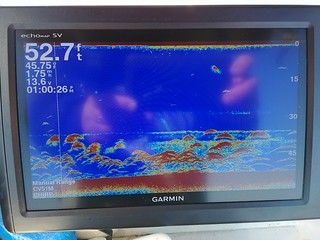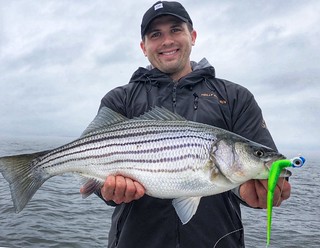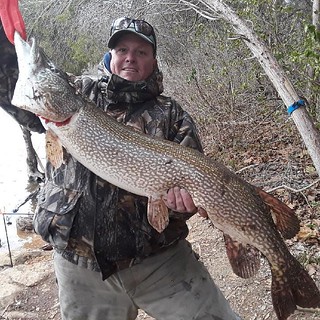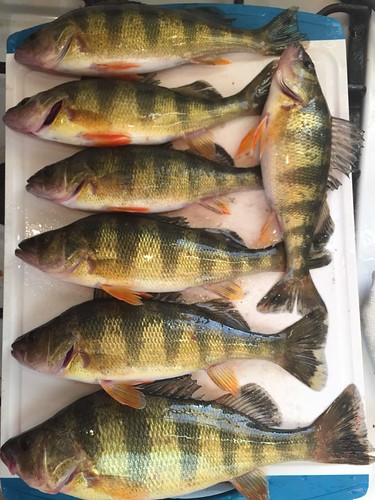Maryland Fishing Report: Dec. 5

Daniel Irons tried his hand at recreational oystering, hand-tonging a nice pile of large oysters that may wind up stewed or fried. Photo by Mike Irons
We are approaching the end of the 2018 striped bass season, which closes Dec. 15. The season ends a few days earlier than last year, as part of the conservation-minded regulations that included reducing the minimum length for Chesapeake Bay rockfish to 19 inches. Of course there are other species that will still be in season for cold-weather anglers.
Expanding your outdoor experiences is a new, learning adventure. It may involve trying a new sport such as bow hunting for a traditional firearm hunter or perhaps fly fishing when you’ve always used spinning gear. There is always something new to explore.
Forecast Summary: Dec. 5 – Dec. 11
With Chesapeake Bay temperatures at 45 degrees and dropping, fish are in or moving towards their winter holding areas or migrating out of the bay. With plenty of cool waters and oxygen from surface to bottom, anglers can avoid waters with poor water clarity from recent, heavy rains. In addition, look for concentrations of fish in some of the warmer bottom waters — greater than 50 degrees, as least 10 degrees warmer than surface waters — located from the Bay Bridge south to near the Maryland state line, on areas with good structure such as underwater points, oyster bottom, reefs, channel edges, and large schools of baitfish.
Cool temperatures will prevail all week — expect sunny to partly cloudy conditions with daytime air temperatures in the upper 30s to the low 40s and night-time temperatures in the low 30s. It will be windy on Thursday.
At the National Oceanic and Atmospheric Administration and Maryland Department of Natural Resources buoys, water temperatures continue to drop, with the Gooses Reef at 45 degrees, Mallows Bay at 43 degrees and Point Lookout at 47 degrees. There is still poor water clarity on the main bay down to Bay Bridge and on the Potomac River down to near Colonial Beach. There will be above average tidal currents on Monday and Tuesday all week at the result of the new moon Dec. 7.
For the full weekly fishing conditions summary and more, please be sure to check out Click Before You Cast.

Rich Watts sent in this photo of his depth finder screen showing white perch and striped bass holding deep and close to the bottom. Photo by Rich Watts
Recent rains in the Susquehanna watershed have led to the Conowingo Dam opening various numbers of flood gates in recent days. Many of the regions tidal rivers are also running high, dumping a lot of freshwater into the bay, which has caused very low salinity values for months.
Most anglers are trolling deep in the channel areas of the upper bay with umbrella rigs and heavy inline weights to troll at depths of 30 feet or more. Chartreuse and pearlescent colors have been popular for sassy shads on umbrella rigs and trailers. Medium-sized bucktails and parachutes dressed with sassy shads have been popular trailers. Bottom bouncing with bucktails dressed with sassy shads has also been an effective way to fish close to the bottom in the deeper channel areas.
Jigging is a light-tackle option that tends to be one of the best options around the deep waters of the Bay Bridge piers, abutments and rock piles. Large soft plastic jigs have been a favorite to target the larger striped bass. Drifting live small eels – if you can get your hands on some – is something no striped bass can resist. The Bay Bridge and Francis Scott Key Bridge piers are great places to try this.
As water temperature continue their downward trend into the 45-degree range, striped bass are becoming sluggish and difficult to entice into feeding. They are more interested in hunkering down and conserving energy. It can be very frustrating when you spot them on depth finders and put every offering you can think of in front of them.
White perch can be found in many of the same deep areas in the bay and tidal river mouths, often over hard bottom, as well as the rock piles at the Bay Bridge. Once you’ve located a white perch on a depth finder, sending a bottom rig or a dropper fly rig tipped with pieces of bloodworm will often get them to bite.
Yellow perch have been moving into the tidal rivers of the upper bay and are providing some fun and rewarding fishing for those fishing from shore, kayaks or small boats. A variety of small jigs or small minnows are excellent ways to catch yellow perch that are holding close to the bottom in the upper reaches of the tidal rivers.
Trolling umbrella rigs with heavy inline weights has been the most popular way to fish and cover water. Unfortunately the best one can describe the action is a slow pick. Most are burning a lot of fuel and slowly covering a lot of the bay for a few fish. Small-diameter umbrella rigs rigged with chartreuse and pearlescent sassy shads have become very popular. The striped bass are holding close to the bottom in 30 feet or more of water.
The deep channel edges along the shipping channel, Bloody Point, the mouth of Eastern Bay and deep areas in Eastern Bay such as Tilghman Point have been good places to troll. The mouth of the Severn River and the False Channel at the mouth of the Choptank River are also worth checking.
The above areas also present some opportunities for jigging. Large soft plastic jigs have been a favorite when targeting the larger fish. Some have been enjoying good luck with jigs that have large eyes and skirts to provide extra attraction.
The warm water discharge at the Calvert Cliffs Nuclear Power Plant is a great place to set up and drift in the discharge current as you jig. It is no secret that the warm water attracts striped bass and sometimes a late-season lingering speckled sea trout.

Joe Matta holds up a healthy striped bass caught recently in the lower bay. Photo by Joshua Kalreider
This region is the last great hope for the final eleven days of striped bass season. The fishing there has been good but is showing signs of slowing down as water temperatures decline further. Trolling tends to be the most productive option along the deep edges of the eastern side of the shipping channel near Buoys 72 and 72A. The mouth of the Potomac River near Smith Point has been good and there are some fish being caught at the mouth of the Patuxent River also.
Small-diameter umbrella rigs in chartreuse, white or pearl have been favorites and it will take a lot of weight to get down to where the fish are holding. Jigging has been a good option also when bait and striped bass can be found together. There have been reports of some sea gull action and sporadic gannet sightings. The striped bass have been feeding primarily on menhaden for the past couple of weeks.
White perch can be found in deep water in the lower section of the Patuxent River at about 40 feet deep over oyster bottom. There are also white perch to be found at the mouth of the Nanticoke and Pocomoke rivers in deep water. Bottom rigs and dropper fly rigs tipped with bloodworms will catch them. Channel catfish can be found in the same areas. In the tidal Potomac from the Route 301 Bridge to the Wilson Bridge, blue catfish rule the river and with the onset of colder water some behemoth-sized blue catfish are being caught on fresh gizzard shad baits.
The Maryland Department of Natural Resources has been soliciting public input to help develop a work plan for the new State Lakes Protection and Restoration Fund, which will provide $1 million for each of the next three years to improve state-owned lakes. Written comments can be sent to the email address listed online.

William Warrington Jr. caught and released this 40-inch northern pike at Loch Raven Reservoir recently. Photo courtesy of William Warrington Jr.
As colder weather steadily lowers water temperatures in Maryland’s freshwater areas, many species are headed for deeper waters to wait out the winter months. Others actually prefer the colder waters, and because of that provide wonderful fishing opportunities in the upcoming months.
At Deep Creek Lake and in the upper Potomac, walleye fishing will improve as the water temperatures dip. Soft plastic jigs and swimbaits worked close to the bottom with or without a lip hooked minnow will catch them. Yellow perch fishing is in full swing at Deep Creek Lake and Piney Reservoir; minnows fished close to the bottom along deep grass lines tends to be where they can be found. Northern pike are active in Deep Creek Lake and selected reservoirs such as Loch Raven Reservoir.
The trout management waters of the western and central regions offer good fishing opportunities this week. Spin casters can use small spinners and spoon in many put-and-take areas that still hold trout that didn’t fall for the Powerbait trick last month. The fly-fishing catch-and-release areas offer exciting action for those drifting nymphs or working streamers or wooly buggers across current flows.

Pictured is a pair of gorgeous brook trout spawning in a redd earlier this fall in a Savage River tributary stream. Photo by Sull McCartney
Department biologists urge anyone wading in streams where brook trout and brown trout might have spawned to avoid treading on trout spawning beds – known as redds — where the eggs are incubating until the fry hatch in spring. Redds can be identified in the stream bottom as a shallow, scooped-out bowl of clean, silt-free gravel, usually much lighter than the surrounding stream substrate. They are usually found in the shallow riffle areas at the tail end of pools.
Chain pickerel fishing always improves with the disappearance of heavy aquatic vegetation during the winter months and the pickerel become more active. They are an ambush predator so look for them holding near fallen treetops or sunken wood. They attack most anything moving through the water with abandon and inhale lures, which often leads to their demise when they get treble hooks tangled up in their gills. Many die-hard pickerel fishermen have found snipping off the barbs on the treble hooks works wonders, and others just replace them with a single J-style hook. Whatever you do, it’s important to have a good pair of long-nosed pliers to remove hooks and stay away from those sharp teeth.
Largemouth bass continue to move towards deeper waters as water temperatures fall. They can still be found in transition areas between the shallower areas and deep channels. A variety of soft plastic grubs, jigs and crankbaits are good choices for working sunken cover. Fallen treetops, sunken logs, rocks, bridge piers are all good places to look for largemouth bass that are hunkered down.
Crappie can also be found schooled up in deep water near bridge piers and sunken wood. A small jig or minnow under a slip bobber is a good way to catch them. The tidal waters of the Potomac near the Wilson Bridge is one of the most productive places to catch crappie; focus near the Spoils alongside the Wilson Bridge ramp on the Maryland side or the marina piers and docks of the Fort Washington area. Fishing for blue catfish has been excellent in the river in this same section of the Potomac.
Anglers have patiently been soaking large baits of cut menhaden in the surf of Ocean City and Assateague Island waiting for the fall migration of striped bass to pass along the Maryland coast. Just like snow birds moving their yachts to southern waters, the major portion of striped bass take a straight line from Long Island to the Virginia Capes and often will be seen 20-30 miles off southern New Jersey and Ocean City. A good portion of the larger ones will poke along the coastal shores and it is hoped they will arrive soon. Until then, striped bass less than 28 inches are being caught in the surf, along with lots of small bluefish and of course clear-nosed skates.
At the inlet and Route 50 Bridge area there are some striped bass and bluefish being caught in the evening hours by casting bucktails and swimshads or drifting cut bait. Some have also had success with live eels for striped bass with a keeper now and then. Trolling in the channels with umbrella rigs up to the Route 90 Bridge has also been accounting for striped bass catches.
Tautog continue to be caught near the inlet jetties, bulkheads and the bridge piers of the Route 50 Bridge. Pieces of green crab or frozen sand fleas have been the baits of choice. Most of the tautog are just under the 16-inch minimum but there are keepers being caught.
The boats headed out to the offshore wreck and reef sites are finding excellent sea bass fishing for their rail huggers. Limit catches of medium to large sized sea bass are the norm this week. There is also a mix of silver and red hake being caught along with bluefish. Unfortunately spiny dogfish are beginning to cover up some of the wreck sites lately and will always be a pesky sidebar. Large tautog are being caught on some of the offshore wreck sites by those who are targeting them.
“A fisherman is always hopeful — nearly always more hopeful than he has good cause to be. He is probably most hopeful of all when he goes out in the early dawn, feeling that he has stolen an hour on his brothers and earned himself a reward by sheer virtue and fortitude. But the hope of the evening rise is a darker, more powerful hope; it is a mysterious time, when miracles may happen.” – Roderick Haig-Brown
Keith Lockwood has been writing the Fishing Report since 2003 and has had a long career as a fisheries research biologist since 1973. Over the course of his career he has studied estuarine fishery populations, ocean species, and over a decade long study of bioaccumulation of chemicals in aquatic species in New Jersey. Upon moving to Oxford on the eastern shore of Maryland; research endeavors focused on a variety of catch-and-release studies as well as other fisheries related research at the Cooperative Oxford Laboratory. Education and outreach to the fishing public has always been an important component to the mission of these studies. Keith is an avid outdoorsman enjoying hunting, fishing, bird dogs, family and life on the eastern shore of Maryland.



 1-888-373-7888
1-888-373-7888 233733
233733